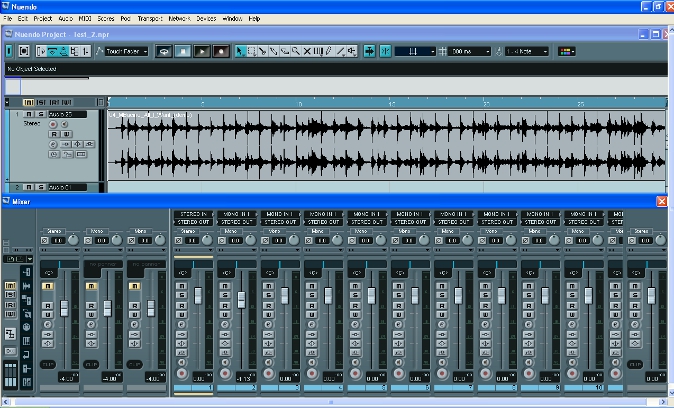Songcraft: Becoming Your Own Producer, Part 4

With a majority of today’s songwriters having powerful recording tools at their disposal, just a laptop’s click away, and the line between home and studio recordings blurring daily, writers/artists are now finding themselves, more and more, in the role of de facto producer when looking to capture their latest creations.
With that thought in mind, Songcraft’s “Becoming Your Own Producer” series will look to dissect, simplify and offer insight into the (sometimes daunting) process and art of DIY music production.
(In case you missed the previous installments of this series, check out parts one, two and three under RELATED CONTENT to the left.)
Mixing
With your song now fully recorded, we’re ready to move into the next phase of the production process, mixing.
• Disclaimer. Not unlike recording, mixing is a subject/art so vast, with approaches so varied, one could never hope to cover the topic properly within the confines of a blog post. There are many great mixing tutorials on the web (One of the best/straightforward can be found here), educate yourself and begin learning the basics. In the meantime, here are some rudimentary thoughts to get you going.
• Monitoring. As was the case with recording, it’s very important that you become sonically familiar with the speakers you’ll be listening through while mixing. You don’t necessarily need expensive studio monitors (although owning a pair couldn’t hurt), just make sure to listen to a lot of music on whatever speakers you’ll be working with before starting to mix so you’ll know what things are “supposed” to sound like in terms of lower, middle and upper frequencies when evaluating your own work.
Get The Pick Newsletter
All the latest guitar news, interviews, lessons, reviews, deals and more, direct to your inbox!
Truth be told, there are many factors that come into play with monitoring; the amplifier you pair your speakers with, the placement of your speakers in the room, the use or lack of acoustic treatment in the space, etc. Educate yourself on the aforementioned when you can, but for now, intimately knowing how other music sounds on your speakers in your space will, at least, give you a solid chance at crafting mixes that will translate decently out in the real world.
• Clean house. Before beginning your mix, take some time to go through each of your recorded tracks (Use the “solo” function in your DAW software) and remove any stray pops, clicks, noises, etc that may have accumulated during the recording process. The rustling of a lyric sheet, the clearing of a throat; it’s best to address these problems now so they won’t interrupt your creative flow once you get down to mixing.
• Adjust recorded volume levels. While tending to your house cleaning duties, also listen to your tracks for any glaringly obvious, internal volume inconsistencies they may have acquired during the record process. If your singer’s vocal gets quiet on the bridge because the dynamics of the song call for that, great, but if one line of the chorus sounds a lot louder than its surrounding phrases, go in and tweak said line down in volume at the waveform level to make it consistent with its neighbors. There are tools/processors that can make these adjustments for you electronically, but you should always try and remedy the larger, more overt problems manually.
• EQ. Equalization, or the process of adjusting the balance between frequency components within an audio signal, is a deep topic worthy (and the subject) of many books, blogs, etc. Do your research, educate yourself (Check this tutorial). But first, here are a few EQ basics to prime the pump:
Try cutting frequencies before boosting them; If, say, an instrument in your mix sounds dark/muddy to your ears, don’t immediately add top end, first try to remove some bottom or low-mid from the signal by either lowering the volume level of those frequencies or by utilizing a high-pass filter to gain the clarity you’re looking for. Boost frequencies only when cutting fails to achieve your desired result. Cutting rather than boosting will keep your mixes phase coherent.
Lastly, think of the sonic space in a mix as real estate. In order for instruments to be heard clearly, they must be assigned their own frequency-based parcel of land, so to speak. If too many instruments try to occupy the same space in the frequency spectrum, they’ll sound muddled and loose their definition. Attempt to carve out unique, frequency homes for as many elements of your mix as possible.
Again, education is key. Try to learn as much as you can about EQ and the fascinating world of frequency that exists between 20Hz and 20KHz.
Next time, “Becoming Your Own Producer” keeps tweaking with the continuation of our mix rundown.
Mark Bacino is a singer/songwriter based in New York City. When not crafting his own melodic brand of retro-pop, Mark can be found producing fellow artists or composing for television/advertising via his Queens English Recording Co. Mark also is the founder/curator of intro.verse.chorus, a website dedicated to exploring the art of songwriting. Visit Mark on Facebook or follow him on Twitter.
"Upgrading from your entry-level acoustic opens the door to an entirely new world of tonewoods, body shapes, and brands": 6 signs it's time to upgrade from your first acoustic guitar
"I'm past my prime": 5 common excuses for not learning the guitar – and 5 body and mind-boosting reasons you should









